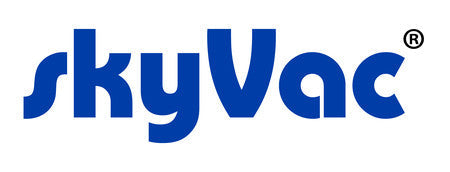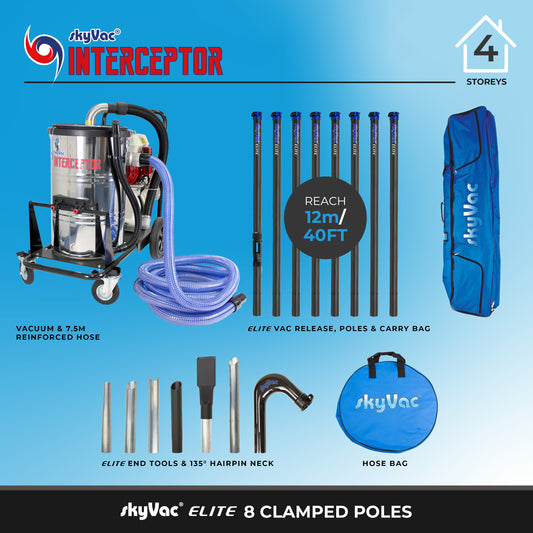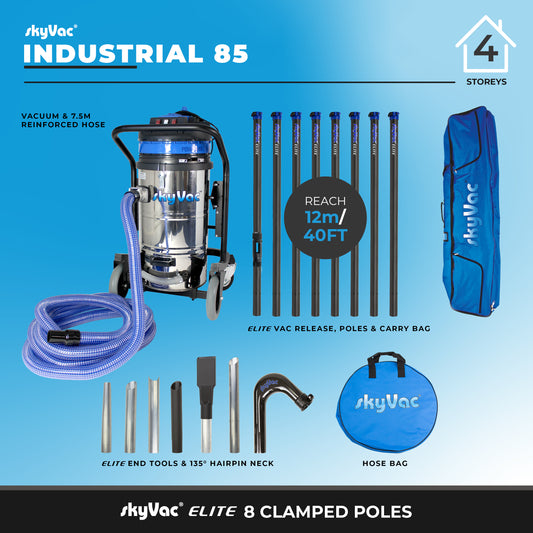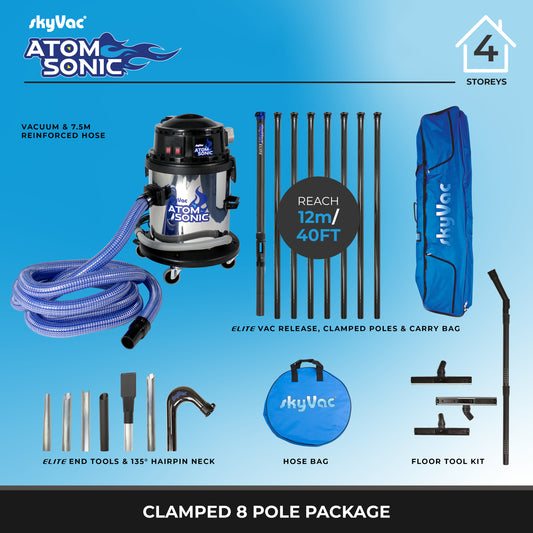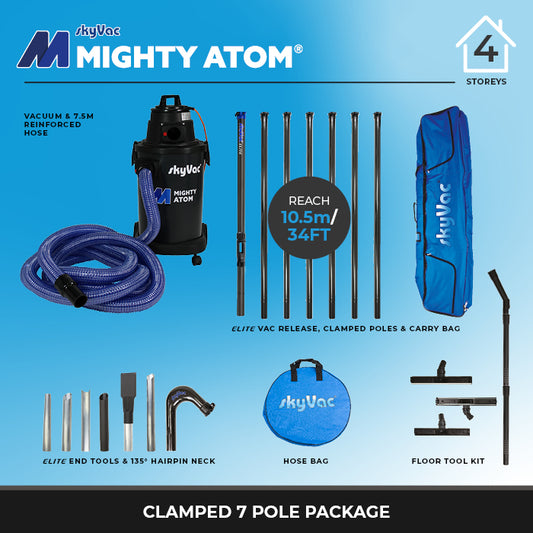Dominando la limpieza comercial de polvo en altura: técnicas esenciales para un ambiente impecable
Compartir
Mantener nuestros espacios comerciales limpios significa mirar hacia arriba, muy arriba. La acumulación de polvo puede no ser lo primero que pensemos, pero es fundamental para la calidad del aire y para que el lugar luzca bien. Vamos a hablar de su importancia y cómo podemos hacerlo bien.
Conclusiones clave
- La limpieza a alta presión es vital para eliminar el polvo, los alérgenos y los posibles riesgos de incendio de las áreas elevadas de difícil acceso en los edificios comerciales.
- El uso de equipos especializados, como sistemas de postes de gran alcance y accesorios de aspiradora adecuados, es clave para una limpieza comercial de gran altura segura y eficaz.
- Los programas de limpieza regulares y el cumplimiento de los protocolos de seguridad son fundamentales para mantener un ambiente impecable y garantizar el cumplimiento durante las operaciones comerciales de limpieza a gran escala.
Entendiendo la importancia de la limpieza de polvo en áreas comerciales
Todos sabemos que el polvo y la suciedad pueden acumularse en cualquier lugar, pero en los espacios comerciales, estas partículas tienden a acumularse en los puntos más altos y de difícil acceso. Piense en la parte superior de las estanterías altas, las vigas del techo, las lámparas y los sistemas de ventilación. Estas áreas suelen pasarse por alto durante la limpieza de rutina, pero son un foco de polvo, telarañas e incluso caspa.
¿Por qué se acumulan el polvo y la caspa en lugares altos?
En realidad, es una simple cuestión de física. El polvo está compuesto de partículas diminutas: células cutáneas muertas, fibras de tela, suciedad y más. La caspa proviene de mascotas y personas. Debido a su ligereza, estas partículas se dispersan fácilmente por el aire. Factores como los sistemas de climatización, el tráfico peatonal e incluso las corrientes de aire pueden levantarlas. Una vez que flotan, se depositan de forma natural en las superficies más cercanas, lo que, en muchos edificios comerciales, significa las más altas. Con el tiempo, esto crea una acumulación considerable que puede ser bastante difícil de eliminar con los métodos de limpieza habituales.
El impacto del alto nivel de polvo en la calidad del aire y la seguridad
Este polvo oculto no solo es antiestético, sino que puede afectar el aire que respiramos y representar riesgos para la seguridad. Al ser removidas, estas partículas depositadas pueden volver a estar suspendidas en el aire, circulando por el edificio y potencialmente provocando alergias o problemas respiratorios a los ocupantes. Para las empresas, especialmente las del sector de la alimentación o la industria manufacturera, este polvo también puede convertirse en un peligro de incendio si se acumula cerca de equipos eléctricos o fuentes de calor. Por lo tanto, mantener limpias las zonas altas no solo se trata de la estética, sino también de crear un entorno más saludable y seguro para todos. El uso de equipos especializados, como los sistemas de postes de alto alcance de SkyVac, nos permite gestionar eficazmente estas zonas de difícil acceso sin necesidad de escaleras ni elevadores, lo que hace que el trabajo sea más seguro y eficiente. Podemos alcanzar hasta 12 metros con estos sistemas, abordando esos puntos difíciles con facilidad. Obtenga más información sobre los sistemas SkyVac .
Descuidar la limpieza a fondo puede provocar un deterioro gradual de la calidad del aire interior y crear peligros ocultos. La atención regular a estas áreas es clave para un espacio comercial verdaderamente limpio y seguro.
Herramientas y técnicas esenciales para la limpieza de polvo en altura en comercios
Cuando hablamos de combatir el polvo en lugares difíciles de alcanzar, contar con el equipo adecuado marca la diferencia. Hemos comprobado que usar equipo especializado no solo facilita el trabajo, sino que también lo hace mucho más seguro. La clave está en contar con las herramientas adecuadas, y para eliminar el polvo a gran escala, esto implica considerar sistemas de pértiga y accesorios de aspiración.
No podemos enfatizar lo suficiente la importancia de tener buenos palos. Estos no son los típicos palos de escoba; hablamos de palos ligeros y extensibles hechos de materiales como fibra de carbono. Estos palos nos permiten limpiar con seguridad áreas de hasta 12 metros del suelo, sin necesidad de escaleras ni elevadores. Esto supone un cambio radical en seguridad y eficiencia.
- Los postes telescópicos ofrecen longitudes ajustables, lo que nos permite ajustar nuestro alcance a diferentes alturas y espacios.
- Los juegos de postes con abrazaderas proporcionan rigidez adicional, lo que es excelente cuando usamos accesorios más pesados o necesitamos una conexión realmente estable.
- La naturaleza liviana de estos bastones significa menos fatiga para nosotros, lo que nos permite trabajar durante períodos más largos sin esfuerzo.
Al utilizar el sistema de postes adecuado podemos acceder a vigas, conductos, artefactos de iluminación y esquinas del techo sin ponernos en riesgo.
Una vez que tenemos nuestros bastones, debemos pensar en qué pasa al final. Para una limpieza eficaz en zonas altas, combinamos nuestros bastones con accesorios específicos diseñados para capturar el polvo y los residuos. Aquí es donde ocurre la verdadera limpieza.
- Los accesorios de aspiradora son clave para una limpieza sin polvo. Buscamos cabezales que se conecten fácilmente a nuestros sistemas de aspiración, especialmente aquellos compatibles con filtros HEPA para atrapar partículas finas.
- Utilizamos una variedad de cepillos y fundas de microfibra . Cada superficie requiere herramientas diferentes. Algunos cepillos están diseñados para llegar a rincones estrechos alrededor de tuberías, mientras que otros son más suaves para accesorios más delicados. Las fundas de microfibra son ideales para superficies que se rayan fácilmente.
- Los adaptadores de ángulo también son muy útiles. Nos permiten sortear obstáculos y acceder a lugares difíciles que de otro modo serían imposibles de alcanzar.
Hemos comprobado que la gama SkyVac ofrece una amplia selección de estas herramientas especializadas, desde las propias varas hasta los diversos cabezales de cepillo y accesorios de aspiración. Contar con la combinación adecuada nos permite abordar prácticamente cualquier problema de polvo intenso de forma eficaz y segura. Esto realmente transforma la forma en que abordamos estas zonas a menudo descuidadas del edificio.
Mejores prácticas para una limpieza eficaz de polvo en zonas comerciales altas
Mantener un ambiente impecable en espacios comerciales implica no olvidarnos de las zonas altas. La limpieza regular de estos puntos es clave para evitar la acumulación de polvo que puede afectar la calidad del aire y la estética general del lugar. Hemos comprobado que cumplir un cronograma y utilizar los métodos adecuados marca la diferencia.
Mantener un ambiente impecable mediante una limpieza regular
Para mantener las cosas siempre limpias, recomendamos algunas cosas:
- Programe limpiezas regulares. Dependiendo de las instalaciones, estas pueden ser mensuales o trimestrales. Una atención constante evita que el polvo se acumule a niveles problemáticos.
- Trabaje de arriba a abajo. De esta manera, el polvo que se desprende durante la limpieza cae sobre las superficies que aún no se han limpiado, en lugar de sobre las áreas recién limpiadas.
- Utilice las herramientas adecuadas para el trabajo. Nuestros sistemas SkyVac, con sus postes extensibles y accesorios especializados, están diseñados para alcanzar estas zonas altas eficazmente sin necesidad de escaleras ni elevadores.
Es fácil pasar por alto los espacios altos, pero estos desempeñan un papel fundamental en la limpieza general y la calidad del aire de un edificio. Un enfoque proactivo previene problemas mayores en el futuro.
Garantizar la seguridad y el cumplimiento durante operaciones con mucha polvo
La seguridad es siempre nuestra máxima prioridad cuando trabajamos en altura. Nos aseguramos de seguir estas pautas:
- Utilice siempre el equipo de protección individual (EPI) adecuado. Esto incluye gafas de seguridad y, según la situación, mascarillas antipolvo.
- Inspeccione todo el equipo antes de usarlo. Revise los postes para detectar cualquier daño y asegúrese de que las fijaciones estén bien sujetas. Esto es especialmente importante con nuestros postes ligeros de fibra de carbono para mantener su integridad.
- Familiarícese con el equipo. Comprender cómo extender, bloquear y maniobrar correctamente las pértigas, como los sistemas telescópicos o con abrazaderas SkyVac, es vital para una operación segura.
- Al utilizar sistemas de aspiración, como el SkyVac 30 o 78, asegúrese de que los filtros estén limpios y en buen estado de funcionamiento para mantener la succión y evitar que el polvo recircule.
Aprenda a eliminar el polvo en altura de forma segura y eficiente. Visite nuestro sitio web hoy mismo para descubrir las mejores herramientas y técnicas para un acabado impecable.
Cómo mantener su espacio comercial impecable, de piso a techo
Hemos hablado mucho sobre cómo el polvo y la suciedad pueden acumularse en esos lugares difíciles de alcanzar en edificios comerciales. No se trata solo de la apariencia, sino también de la calidad del aire y la seguridad. Hemos visto cómo herramientas como los sistemas SkyVac, con sus largos tubos y potentes aspiradoras, nos permiten realizar estas tareas de limpieza a gran altura de forma segura desde el suelo. Esto significa que podemos limpiar techos, conductos de ventilación y lámparas sin necesidad de escaleras ni elevadores, lo cual es una gran ventaja para la eficiencia y la seguridad de todos. Al utilizar el equipo y las técnicas adecuadas, podemos garantizar que los espacios de nuestros clientes estén realmente limpios, desde los rincones más altos hasta el suelo.
Preguntas frecuentes
¿Por qué necesitamos limpiar las zonas altas en los edificios comerciales?
Necesitamos limpiar las zonas altas porque el polvo, la suciedad y otras partículas diminutas flotan y se depositan allí con el tiempo. Esta acumulación puede empeorar la calidad del aire en nuestros edificios, lo cual es perjudicial para la salud. Además, el polvo acumulado puede ser un peligro de incendio, especialmente cerca de luces o equipos eléctricos. La limpieza regular mantiene nuestros espacios más saludables y seguros.
¿Qué tipo de herramientas utilizamos para limpiar grandes cantidades de polvo?
Utilizamos postes largos especiales, a menudo fabricados con materiales ligeros como la fibra de carbono, que nos permiten llegar a lugares altos sin necesidad de escaleras ni elevadores. Estos postes pueden equiparse con diferentes accesorios de limpieza, como cepillos o cabezales de aspiración, para recoger el polvo y los residuos. Algunos sistemas incluso utilizan aspiradoras con filtros especiales para atrapar el polvo de forma segura.
¿Con qué frecuencia debemos realizar una limpieza a gran altura?
El mejor programa depende del edificio y de su actividad. En muchos locales comerciales, recomendamos realizar una limpieza a fondo cada tres a seis meses. Sin embargo, si hay mucho polvo o necesidades específicas, podríamos necesitar una limpieza más frecuente, quizás mensual, para mantenerlo en óptimas condiciones.
